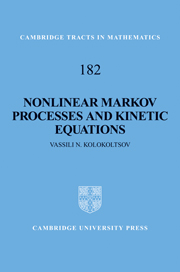Book contents
- Frontmatter
- Contents
- Preface
- Basic definitions, notation and abbreviations
- 1 Introduction
- Part I Tools from Markov process theory
- Part II Nonlinear Markov processes and semigroups
- Part III Applications to interacting particles
- 9 The dynamic law of large numbers
- 10 The dynamic central limit theorem
- 11 Developments and comments
- Appendices
10 - The dynamic central limit theorem
from Part III - Applications to interacting particles
Published online by Cambridge University Press: 05 July 2014
- Frontmatter
- Contents
- Preface
- Basic definitions, notation and abbreviations
- 1 Introduction
- Part I Tools from Markov process theory
- Part II Nonlinear Markov processes and semigroups
- Part III Applications to interacting particles
- 9 The dynamic law of large numbers
- 10 The dynamic central limit theorem
- 11 Developments and comments
- Appendices
Summary
Our program of interpreting a nonlinear Markov process as the LLN limit of an approximating Markov interacting-particle system was fulfilled in Chapter 9 for a wide class of interactions. In this chapter we address the natural next step in the analysis of approximating systems of interacting particles. Namely, we deal with processes involving fluctuations around the dynamic LLN limit. The objective is to show that in many cases the limiting behavior of a fluctuation process is described by an infinite-dimensional Gaussian process of Ornstein–Uhlenbeck type. This statement can be called a dynamic central limit theorem (CLT). As in Chapter 9 we start with a formal calculation of the generator for the fluctuation process in order to be able to compare it with the limiting second-order Ornstein–Uhlenbeck generator. Then we deduce a weak form of the CLT, though with precise convergence rates. Finally we sketch the proof of the full result (i.e. the convergence of fluctuation processes in a certain Skorohod space of càdlàg paths with values in weighted Sobolev spaces) for a basic coagulation model, referring for details to the original paper.
Generators for fluctuation processes
In this section we calculate generators for fluctuation processes of approximating Markov interacting-particle systems around their LLNs, which are given by solutions to kinetic equations. Here we undertake only general, formal, calculations without paying much attention to the precise conditions under which the various manipulations actually make sense. We postpone to later sections justifying the validity of these calculations for concrete models in various strong or weak topologies under differing assumptions. The calculations are lengthy but straightforward.
- Type
- Chapter
- Information
- Nonlinear Markov Processes and Kinetic Equations , pp. 252 - 274Publisher: Cambridge University PressPrint publication year: 2010



